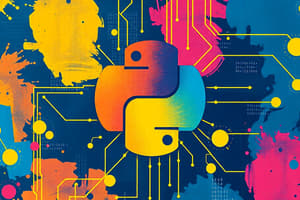Podcast
Questions and Answers
Which library is specifically used for machine learning tasks in Python?
Which library is specifically used for machine learning tasks in Python?
- Matplotlib
- NumPy
- Scikit-learn (correct)
- Pandas
What is the primary purpose of the try...except blocks in Python?
What is the primary purpose of the try...except blocks in Python?
- To define the scope of variables.
- To handle exceptions during program execution. (correct)
- To create comments in the code.
- To improve performance in loops.
Which of the following operators is used for exponentiation in Python?
Which of the following operators is used for exponentiation in Python?
- ** (correct)
- ==
- %
- //
What is the significance of indentation in Python programming?
What is the significance of indentation in Python programming?
Which of the following libraries would you use primarily for data visualization?
Which of the following libraries would you use primarily for data visualization?
What is a key characteristic of Python being an interpreted language?
What is a key characteristic of Python being an interpreted language?
Which data type in Python is mutable?
Which data type in Python is mutable?
What do conditional statements in Python utilize for decision-making?
What do conditional statements in Python utilize for decision-making?
What feature of Python supports encapsulation and modularity in programming?
What feature of Python supports encapsulation and modularity in programming?
Which of the following is NOT a characteristic of Python's high-level programming?
Which of the following is NOT a characteristic of Python's high-level programming?
What is the purpose of using modules in Python?
What is the purpose of using modules in Python?
Which programming paradigms are supported by Python's extensive libraries?
Which programming paradigms are supported by Python's extensive libraries?
What is the role of packages in Python?
What is the role of packages in Python?
Flashcards
NumPy
NumPy
A Python library for numerical computations and array manipulation. It's the foundation for many scientific and data-heavy applications.
Dynamic Typing
Dynamic Typing
Python's dynamic typing allows variable declaration without explicitly specifying data types. This gives you flexibility, but be mindful of potential type mismatch issues.
Indentation
Indentation
In Python, indentation defines the scope of code within loops, conditional statements, functions, and other code blocks. This helps maintain code clarity and prevents errors.
Try...Except Blocks
Try...Except Blocks
Signup and view all the flashcards
Flask
Flask
Signup and view all the flashcards
Interpreted Language
Interpreted Language
Signup and view all the flashcards
High-level Language
High-level Language
Signup and view all the flashcards
General-Purpose Language
General-Purpose Language
Signup and view all the flashcards
Dictionary
Dictionary
Signup and view all the flashcards
Conditional Statements
Conditional Statements
Signup and view all the flashcards
Functions
Functions
Signup and view all the flashcards
Package
Package
Signup and view all the flashcards
Classes in Object-Oriented Programming
Classes in Object-Oriented Programming
Signup and view all the flashcards
Study Notes
-
Python is an interpreted, high-level, general-purpose programming language.
-
Its design philosophy emphasizes code readability through significant indentation.
-
Python's extensive libraries support various programming paradigms, including object-oriented, imperative, and functional approaches.
Key Features
-
Interpreted: Python code is executed line by line by an interpreter, unlike compiled languages that translate the entire code into machine code beforehand. This enables faster development, but slower execution for computationally intensive tasks.
-
High-level: Python abstracts low-level details like memory management, simplifying coding but potentially limiting direct system resource control.
-
General-purpose: Python is applicable across diverse domains, from web development and scientific computing to data analysis.
Data Types
-
Numeric: Includes integers, floats, and complex numbers, supporting mathematical operations.
-
Boolean: Represents truth values (True/False), used in conditional statements and logical operations.
-
String: Represents sequences of characters, offering string manipulation methods.
-
List: Ordered, mutable sequence of items, accommodating various data types.
-
Tuple: Ordered, immutable sequence of items for fixed data collections.
-
Dictionary: Collection of key-value pairs for data storage and retrieval based on keys.
Control Flow
-
Conditional Statements:
if,elif, andelsefor decision-making based on conditions. -
Looping:
forandwhileloops for repeated execution.
Functions
-
Python encloses code blocks into functions, promoting modularity and reusability.
-
Functions can accept arguments and return values.
-
Python supports function overloading (defining multiple functions with the same name but different parameters).
Modules and Packages
-
Modules: Python files containing reusable functions and data, aiding in code organization.
-
Packages: Collections of modules that structure larger projects, essential for complex application development.
Object-Oriented Programming (OOP)
-
Python supports OOP through classes to define objects and inherit functionalities from existing classes.
-
Class structures are vital for building flexible and complex applications.
Libraries
-
Python's extensive libraries enable diverse tasks:
-
NumPy: For numerical calculations and array manipulation; key for scientific computing.
-
Pandas: For data analysis and manipulation; excellent for data processing.
-
Matplotlib: For data visualization.
-
Scikit-learn: A machine learning library with various algorithms and tools for data prediction.
-
Requests: Simplifies HTTP requests for interacting with web resources.
-
Django and Flask: Popular web development frameworks for building dynamic web applications.
-
Syntax Highlights
-
Indentation: Indentation is critical for code blocks within loops, conditional statements, and functions.
-
Comments: Use the
#symbol for comments to clarify code. -
Variable Declaration: Python is dynamically typed; variables need no explicit type declarations.
-
Data structures: Includes lists, tuples, dictionaries, and sets for data organization.
Error Handling
try...exceptblocks: Handle potential exceptions during program execution; crucial for error management and program stability.
File Handling
- Python provides features to read and write text files for data input/output operations.
Common Operators
-
Arithmetic: Standard arithmetic operators (+, -, *, /, //, %, **)
-
Comparison: Comparison operators (==, !=, >, <, >=, <=)
-
Logical: Logical operators (and, or, not)
Other Concepts
-
Built-in Functions: Python offers many built-in functions like
len(),print(), as part of the core language. -
Input/Output: Python supports user interaction (input) and output to the console.
General Applicability
- Python's versatility applies to web development, scripting, data science, machine learning, automation, and game development.
Development Environment
-
Python runs on various operating systems (Windows, macOS, Linux).
-
Integrated Development Environments (IDEs) and code editors help with developing, testing, and debugging Python code.
Studying That Suits You
Use AI to generate personalized quizzes and flashcards to suit your learning preferences.
Description
Explore the fundamental concepts of Python, an interpreted, high-level programming language known for its code readability and versatility. This quiz covers key features, including its interpreted nature, data types, and applicability across various programming paradigms.




